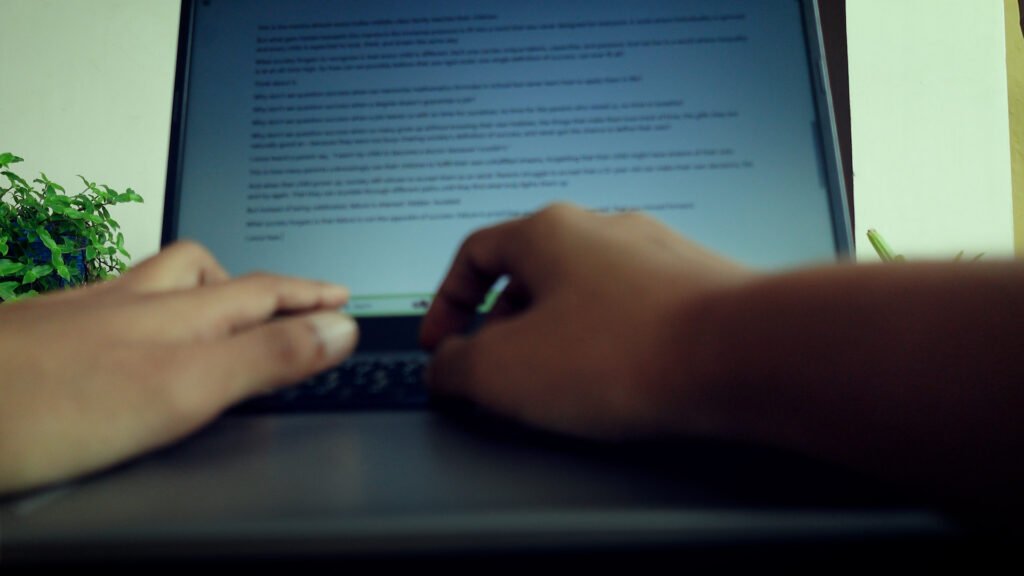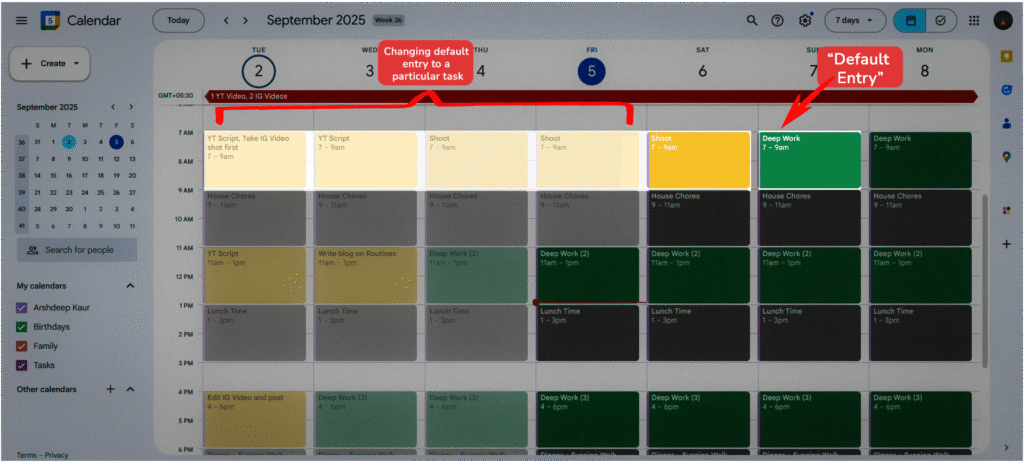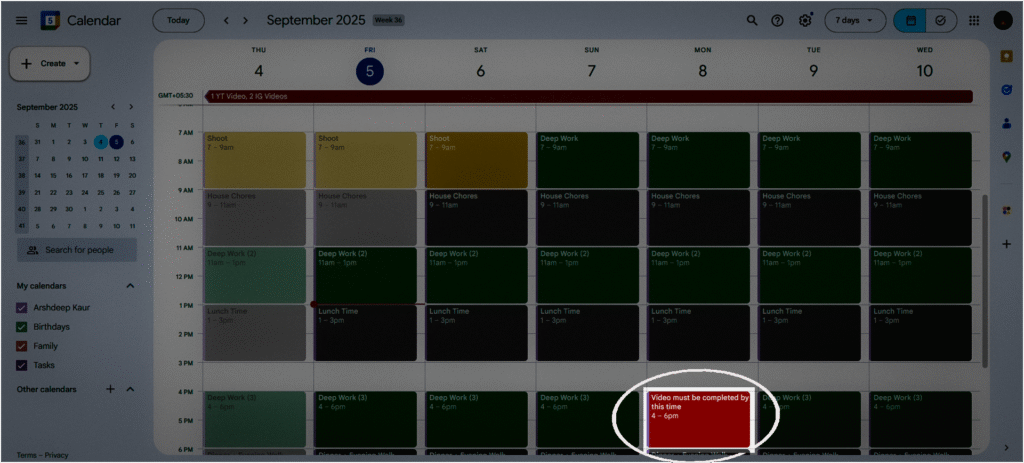Why & How I Follow a Fixed Work Routine at Home?

In the blog:
Introduction
If there’s one thing I’m truly proud of, it’s that I’ve learned to be self-disciplined. In a creative career, no one sets deadlines for you. No one tells you when to begin, when to pause, or when to stop. You are both the boss and the employee.
And that’s where I see the difference. In a 9-to-5, discipline is often born out of compulsion, not out of choice. People show up at 9 even when they don’t feel like it. They meet deadlines because they’re told to, not because they want to.
But my discipline is different. I wake up at 6 because I love writing scripts in the morning when my mind is sharp. I read books because my mind craves knowledge and growth. I learn new skills because they bring me joy. I choose to do things on time because procrastination serves no one.
My discipline isn’t forced on me. It doesn’t come from pressure or someone else’s rules. It’s born from choice—every single day. And I believe that kind of discipline, the one we choose for ourselves, is the discipline that shapes a truly meaningful life.
Here are a few practices that help me stay disciplined while working at home:
1. Focused Work Over Endless Hours
One of the biggest mistakes I made in the beginning was thinking that productivity meant working for as many hours as possible. But I quickly learned that the longer I stretched myself on a single task, the more drained and restless I felt. That exhaustion would then spill into the rest of the day, leaving me unable to give my best to anything else. A 4–5 hour stretch of work may look impressive on paper, but in reality, it often leaves you too exhausted to function afterward.
That’s why I shifted my approach to shorter, focused work sessions of about 2 to 2.5 hours. These bursts are long enough to dive deep into meaningful work but short enough to leave energy for the rest of the day. Whether I’m scripting, filming, or editing, I stop before reaching the point of burnout. The goal is not just to finish one task but to sustain energy across all tasks. This way, I end my workday with enough focus left to enjoy other parts of life, instead of being completely drained.
If you want to learn more about Deep Work, watch this video:
2. Default Deep Work Sessions
Another practice that has changed my workflow is creating default entries for deep work sessions in my Google Calendar. Instead of waking up and deciding “what to do today,” I’ve blocked fixed hours for focus. This removes decision fatigue and conditions my subconscious to treat those hours as non-negotiable work slots. My three sessions are simple: 7–9 am, 11–1 pm, and 4–6 pm.
What I like most about this approach is its flexibility within structure. The entry may say “Deep Work,” but once the session begins, I simply rename it to the actual task of the day—like writing a script, filming content, or editing. This allows me to stay consistent with work hours without being rigid about the type of work. Over time, this routine has trained my brain to enter focus mode at these times almost automatically, which makes discipline feel effortless instead of forced.

3. Embracing Mornings as a Gift
For me, mornings are the most precious part of the day. The world is quiet, the air feels fresh, and even the birds seem to remind me that life is beginning anew. There is a certain stillness in the early hours that creates the perfect environment for clarity and deep thinking. I’ve noticed that as the day progresses, my ability to focus decreases. That’s why I dedicate my first deep work session, from 7 to 9 am, to the most important and mentally demanding tasks like scripting.
The beauty of mornings lies in how they set the tone for the rest of the day. Starting my day with meaningful work gives me a sense of accomplishment early on, which fuels me with energy and motivation for everything else. On days when I shoot content in the morning, I notice the same effect—the rest of the day flows more smoothly. I truly believe that mornings are a blessing, and using them wisely can completely transform not just productivity, but also how peaceful and intentional a day feels.
4. Working With Deadlines
When I first started creating content, I used to take months to finish a single 5–7 minute video. There were always excuses—waiting for the perfect idea, refining endlessly, or getting distracted by smaller things. Without deadlines, work can stretch infinitely, and the longer it stretches, the harder it becomes to finish. This was one of the main reasons my early journey as a creator felt slow and frustrating.
That changed when I began setting deadlines for myself using my calendar. Now, I decide in advance when a video must be finished, and I break down the work into smaller slots within my deep work sessions. Working under deadlines not only keeps me accountable but also helps me manage time without compromising on quality. Today, I can complete a video in about a week, something I couldn’t have imagined earlier. Deadlines, when chosen by yourself, become less about pressure and more about clarity—they give direction to your creativity.

5. Tackling Small Tasks Without Special Time Slots
Small tasks often appear unimportant, but when ignored, they pile up into frustrating problems. I used to postpone things like managing Google storage, cleaning up my phone gallery, or dealing with digital clutter. Over time, these “minor” issues grew so big that they began interfering with my actual work. The lesson I learned was simple: neglecting the small stuff eventually steals energy from the big stuff.
Instead of giving these tasks a separate, dedicated slot, I now work on them for 20–30 minutes after my deep work sessions. For instance, right after finishing my scripting session in the morning, I might spend 20 minutes clearing Google Drive. Doing this daily ensures steady progress without overwhelming me. This way, small but important tasks get handled consistently, and I no longer carry the mental burden of things left undone. It’s amazing how much lighter and more focused you feel when these background tasks are under control.
Final Reflection
Discipline doesn’t have to feel like a burden. For me, it’s about creating rhythms that make work feel natural, not forced. By focusing in shorter sessions, reserving mornings for the most important tasks, working with deadlines, and even handling small chores daily, I’ve built a routine that supports both productivity and peace of mind.
At the end of the day, the most powerful discipline is the one that comes from choice. The kind where you wake up each morning and decide to live with intention, not compulsion. That’s why I follow a fixed work routine at home—not because I have to, but because I choose to. And in that choice lies the freedom to create a life that feels truly meaningful.
1 thought on “Why & How I Follow a Fixed Work Routine at Home?”
I’d love to know if you found the blog valuable. Share your views below!